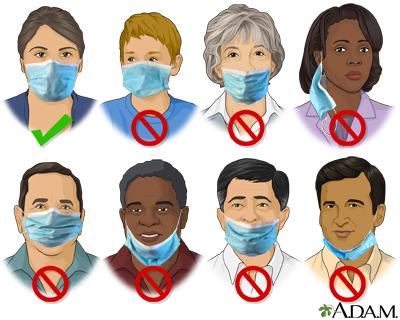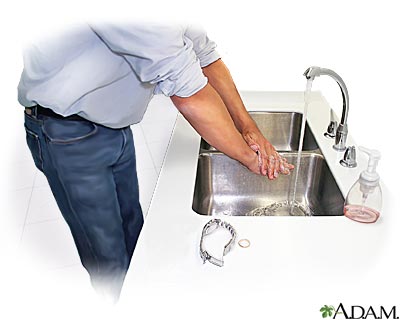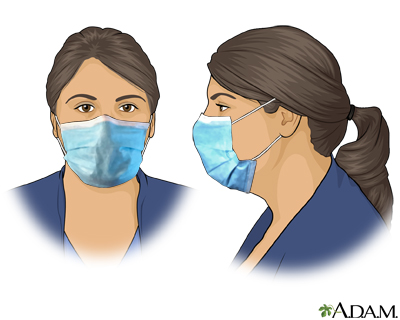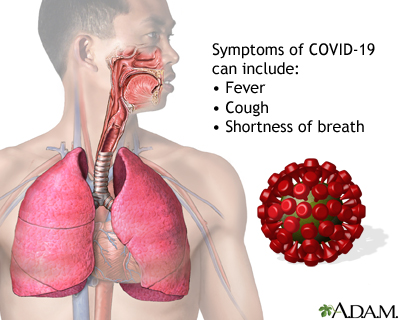COVID-19 – what to do when you are sick
COVID-19 isolation; COVID-19 home isolation; Home isolation and COVID-19
Images




I Would Like to Learn About:
Description
Staying at home when you have COVID-19 helps protect other people who are not infected with the virus. You should stay at home and away from other people until it is safe to be around others.
How to Isolate from Other People
Even if you have been vaccinated, you should stay at home and away from others inside and outside your home if you have symptoms of COVID-19, with or without a positive test.
These are important steps you can take to help prevent spreading COVID-19.
- As much as possible, stay in a specific room and away from others in your home. Use a separate bathroom if you can. Do not leave your home except to get medical care.
- Avoid traveling while sick. If you need to travel while sick, wear a mask to prevent spreading the virus to others.
- Take care of yourself by getting plenty of rest, taking over-the-counter medicines for specific symptoms, and staying hydrated.
- Keep track of your symptoms (such as a fever >100.4°F or >38°C, cough, shortness of breath). You may receive instructions from your health care provider on how to check and report your symptoms.
- Stay in touch with your provider Ask your provider if you are eligible for treatment with antiviral medicines (such as Paxlovid). Antiviral medicines help protect people at risk from getting severe illness.
- If you have severe symptoms, call 911 or the local emergency number.
- Use a well-fitting face mask or respirator that fits well over your nose and mouth without gaps when you see your provider and anytime other people are in the same room with you. If you can't wear a mask, for example, due to breathing problems, people in your home should wear a mask if they need to be in the same room with you.
- Avoid contact with pets or other animals. While rare, SARS-CoV-2 can spread from people to animals.
- Cover your mouth and nose with a tissue or your sleeve (not your hands) when coughing or sneezing. Droplets that are released when a person sneezes or coughs are infectious. Throw out the tissue after use.
- Wash your hands many times a day with soap and running water for at least 20 seconds. Do this before eating or preparing food, after using the toilet, and after coughing, sneezing, or blowing your nose. If soap and water are not easily available, you should use an alcohol-based hand sanitizer that contains at least 60% alcohol.
- Avoid touching your face, eyes, nose, and mouth with unwashed hands.
- Do not share personal items such as cups, eating utensils, towels, or bedding. Wash anything you have used in soap and water.
- Clean all high-touch areas in the home, such as doorknobs, bathroom and kitchen fixtures, toilets, phones, tablets, counters, and other surfaces. Use a household cleaning spray and follow instructions for use.
- Take steps to improve ventilation in your home. You can do this by opening windows, turning on exhaust fans in your bathrooms and kitchen, using portable high-efficiency particulate air (HEPA) cleaners, and setting the fan on your furnace or air conditioning to "on" if you have central heating and cooling in your home.
When to End Home Isolation
Once you start to feel better, you can go back to your normal activities if both of the following things are true:
- For at least 24 hours, your symptoms have improved and
- You have not had a fever for at least 24 hours, and you are not using fever-reducing medicine
Even though you feel better, you may still be able to spread the virus to others for several days. For this reason, once you go back to your normal activities, protect others from illness by continuing to take these steps for 5 days:
- Practice good hygiene by washing your hands and cleaning "high touch" areas around your home
- Take steps to bring cleaner air inside your home by opening windows and using exhaust fans
- Wear a mask around others
- Practice physical distancing by avoiding close contact and avoiding crowds
- Self-test for COVID-19 before being indoors with others
You should also practice these steps for 5 days if you tested positive for COVID-19, but did not have any symptoms. Even though you have no symptoms, you can still spread the virus to others. Doing so will protect people at risk for serious illness, such as people who are immunocompromised.
If your fever returns after resuming normal activities, you should go back to staying home and away from others. Once your fever and symptoms improve for more than 24 hours, you can resume activities while taking steps to protect others for 5 more days.
When to Call the Doctor
You should contact your provider:
- If you have symptoms and think you may have COVID-19
- If you have COVID-19 and your symptoms are getting worse
Call 911 or the local emergency number if you have:
- Trouble breathing
- Chest pain or pressure
- Confusion or inability to wake up
- Blue, gray, or pale skin, lips, face, or nail beds
- Any other symptoms that are severe or concern you
References
Centers for Disease Control and Prevention website. Respiratory illnesses: preventing the spread of respiratory viruses when you're sick. www.cdc.gov/respiratory-viruses/prevention/precautions-when-sick.html. Updated March 1, 2024. Accessed January 6, 2025.
Centers for Disease Control and Prevention website. Respiratory illnesses: respiratory virus guidance. www.cdc.gov/respiratory-viruses/guidance/. Updated March 1, 2024. Accessed January 6, 2025.
BACK TO TOPReview Date: 1/1/2025
Reviewed By: Linda J. Vorvick, MD, Clinical Professor Emeritus, Department of Family Medicine, UW Medicine, School of Medicine, University of Washington, Seattle, WA. Also reviewed by David C. Dugdale, MD, Medical Director, Brenda Conaway, Editorial Director, and the A.D.A.M. Editorial team.

Health Content Provider
06/01/2025
|
A.D.A.M., Inc. is accredited by URAC, for Health Content Provider (www.urac.org). URAC's accreditation program is an independent audit to verify that A.D.A.M. follows rigorous standards of quality and accountability. A.D.A.M. is among the first to achieve this important distinction for online health information and services. Learn more about A.D.A.M.'s editorial policy, editorial process and privacy policy. A.D.A.M. is also a founding member of Hi-Ethics. This site complied with the HONcode standard for trustworthy health information from 1995 to 2022, after which HON (Health On the Net, a not-for-profit organization that promoted transparent and reliable health information online) was discontinued. |
The information provided herein should not be used during any medical emergency or for the diagnosis or treatment of any medical condition. A licensed medical professional should be consulted for diagnosis and treatment of any and all medical conditions. Links to other sites are provided for information only -- they do not constitute endorsements of those other sites. © 1997- 2025 A.D.A.M., a business unit of Ebix, Inc. Any duplication or distribution of the information contained herein is strictly prohibited.
